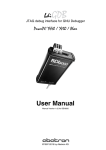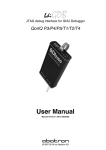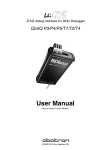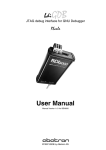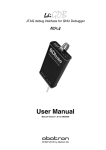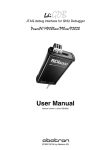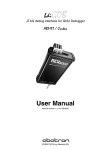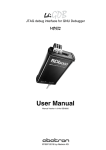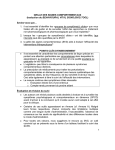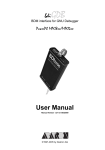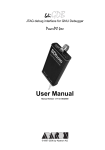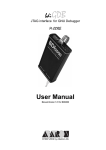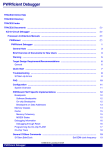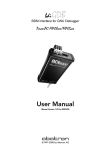Download bdiGDB User Manual
Transcript
bdi GDB
JTAG debug interface for GNU Debugger
PA6T
User Manual
Manual Version 1.00 for BDI3000
©1997-2008 by Abatron AG
bdiGDB for BDI3000 (PA6T)
User Manual
2
1 Introduction ................................................................................................................................. 3
1.1 BDI3000................................................................................................................................. 3
1.2 BDI Configuration .................................................................................................................. 4
2 Installation ................................................................................................................................... 5
2.1 Connecting the BDI3000 to Target ........................................................................................ 5
2.2 Connecting the BDI3000 to Power Supply ............................................................................ 7
2.3 Status LED «MODE»............................................................................................................. 8
2.4 Connecting the BDI3000 to Host ........................................................................................... 9
2.4.1 Serial line communication ............................................................................................ 9
2.4.2 Ethernet communication ............................................................................................ 10
2.5 Installation of the Configuration Software ............................................................................ 11
2.5.1 Configuration with a Linux / Unix host........................................................................ 12
2.5.2 Configuration with a Windows host ............................................................................ 14
2.5.3 Configuration via Telnet / TFTP ................................................................................. 16
2.6 Testing the BDI3000 to host connection.............................................................................. 18
2.7 TFTP server for Windows .................................................................................................... 18
3 Using bdiGDB ............................................................................................................................ 19
3.1 Principle of operation........................................................................................................... 19
3.2 Configuration File ................................................................................................................ 20
3.2.1 Part [INIT]................................................................................................................... 21
3.2.2 Part [TARGET] ........................................................................................................... 23
3.2.3 Part [HOST]................................................................................................................ 27
3.2.4 Part [FLASH] .............................................................................................................. 29
3.2.5 Part [REGS] ............................................................................................................... 34
3.3 Debugging with GDB ........................................................................................................... 36
3.3.1 Target setup ............................................................................................................... 36
3.3.2 Connecting to the target............................................................................................. 36
3.3.3 GDB monitor command.............................................................................................. 37
3.3.4 Target serial I/O via BDI............................................................................................. 38
3.4 Telnet Interface.................................................................................................................... 39
3.5 Multi-Core Support .............................................................................................................. 41
3.6 Low level JTAG mode ......................................................................................................... 42
4 Specifications ............................................................................................................................ 43
5 Environmental notice................................................................................................................ 44
6 Declaration of Conformity (CE)................................................................................................ 44
7 Warranty..................................................................................................................................... 45
Appendices
A Troubleshooting ....................................................................................................................... 46
B Maintenance .............................................................................................................................. 47
C Trademarks ............................................................................................................................... 47
© Copyright 1997-2008 by ABATRON AG Switzerland
V 1.00
bdiGDB for BDI3000 (PA6T)
User Manual
3
1 Introduction
bdiGDB enhances the GNU debugger (GDB), with JTAG/COP debugging for P.A. Semi PA6T based
targets. With the built-in Ethernet interface you get a very fast code download speed. No target communication channel (e.g. serial line) is wasted for debugging purposes. Even better, you can use fast
Ethernet debugging with target systems without network capability. The host to BDI communication
uses the standard GDB remote protocol.
An additional Telnet interface is available for special debug tasks (e.g. force a hardware reset,
program flash memory).
The following figure shows how the BDI3000 interface is connected between the host and the target:
Target System
PA6T
1682
COP Interface
BDI3000
GNU Debugger
(GDB)
Ethernet (10/100 BASE-T)
1.1 BDI3000
The BDI3000 is the main part of the bdiGDB system. This small box implements the interface between the JTAG pins of the target CPU and a 10/100Base-T Ethernet connector. The firmware of the
BDI3000 can be updated by the user with a simple Linux/Windows configuration program or interactively via Telnet/TFTP. The BDI3000 supports 1.2 – 5.0 Volts target systems.
© Copyright 1997-2008 by ABATRON AG Switzerland
V 1.00
bdiGDB for BDI3000 (PA6T)
User Manual
4
1.2 BDI Configuration
As an initial setup, the IP address of the BDI3000, the IP address of the host with the configuration
file and the name of the configuration file is stored within the flash of the BDI3000.
Every time the BDI3000 is powered on, it reads the configuration file via TFTP.
Following an example of a typical configuration file:
;bdiGDB configuration file for PA6T-1682
;--------------------------------------;
;
[INIT]
;
; Test the EXEC init list entry, load r3 with a pattern
;EXEC
0x7c7a4aa6 0x123456789abcdef0 ; mfspr r3,HSRR0
;
[TARGET]
CPUTYPE
;CPUTYPE
JTAGCLOCK
POWERUP
RESET
WAKEUP
;STARTUP
STARTUP
;STARTUP
BREAKMODE
;STEPMODE
STEPMODE
;
CATCH
;
[HOST]
IP
FILE
FORMAT
PROMPT
PA6T
;the CPU type
PA6T 32BIT
;the CPU type, 32-bit GDB protocol
1
;use 16 MHz JTAG clock
2000
;start delay after power-up detected in ms
HARD 1000
;assert reset pin for 1 second
200
;give reset time to complete
RUN
;let the CPU run
STOP 8000
;let boot code setup the system
HALT
;halt at boot vector
HARD
;SOFT or HARD, HARD uses PPC hardware breakpoint
JTAG
;JTAG or HWBP, HWPB uses a hardware breakpoint
HWBP
;JTAG or HWBP, HWPB uses a hardware breakpoint
MCHK HDEC DEC EXT ILLG PRIV FPUN VXUN SC ALNG
; catch some exceptions
151.120.25.112
E:\temp\dump1024k.bin
BIN 0x00010000
PA6T>
[FLASH]
; only to test execution of target code
WORKSPACE
0x0001000
;workspace in SDRAM
CHIPTYPE
AM29BX16
;Flash type
CHIPSIZE
0x00800000
;The size of one flash chip in bytes
BUSWIDTH
16
;The width of the flash memory bus in bits
FILE
E:\temp\dump16k.bin
FORMAT
BIN 0x00100000
[REGS]
FILE
$regPA6T.def
Based on the information in the configuration file, the target is automatically initialized after every reset.
© Copyright 1997-2008 by ABATRON AG Switzerland
V 1.00
bdiGDB for BDI3000 (PA6T)
User Manual
5
2 Installation
2.1 Connecting the BDI3000 to Target
The cable to the target system is a 16 pin flat ribbon cable. In case where the target system has an
appropriate connector, the cable can be directly connected. The pin assignment is in accordance with
the PowerPC COP connector specification.
!
In order to ensure reliable operation of the BDI (EMC, runtimes, etc.) the target cable length must not
exceed 20 cm (8").
Target System
1
PA6T
15
COP/JTAG Connector
16
2
TRGT
MODE
BDI
BDI3000
TARGET A
15
TARGET B
16
1
2
The green LED «TRGT» marked light up when target is powered up
1 - TDO
2 - NC
3 - TDI
4 - TRST
5 - NC
6 - Vcc Target
7 - TCK
8 - NC
9 - TMS
10 - NC
11 - NC
12 - GROUND
13 - RESET
14 - NC
15 - NC
16 - GROUND
For BDI TARGET B connector signals see table on next page.
Warning:
Before you can use the BDI3000 with an other target processor type (e.g. PPC <--> ARM), a new
setup has to be done (see chapter 2.5). During this process the target cable must be disconnected
from the target system.
!
To avoid data line conflicts, the BDI3000 must be disconnected from the target system while
programming a new firmware for an other target CPU.
© Copyright 1997-2008 by ABATRON AG Switzerland
V 1.00
bdiGDB for BDI3000 (PA6T)
User Manual
6
BDI TARGET B Connector Signals:
Pin
Name
Description
1
TDO
JTAG Test Data Out
This input to the BDI3000 connects to the target TDO pin.
2
<reserved>
3
TDI
JTAG Test Data In
This output of the BDI3000 connects to the target TDI pin.
4
TRST
JTAG Test Reset
This output of the BDI3000 resets the JTAG TAP controller on the target.
5
<reserved>
6
Vcc Target
1.2 – 5.0V:
This is the target reference voltage. It indicates that the target has power and it is also used
to create the logic-level reference for the input comparators. It also controls the output logic
levels to the target. It is normally fed from Vdd I/O on the target board.
7
TCK
JTAG Test Clock
This output of the BDI3000 connects to the target TCK pin.
8
<reseved>
9
TMS
10
<reseved>
11
<reserved>
12
GROUND
System Ground
13
RESET
Reset
This open collector output of the BDI2000 connects to the target RESET pin.
14
<reseved>
15
<reserved>
16
GROUND
JTAG Test Mode Select
This output of the BDI3000 connects to the target TMS line.
System Ground
© Copyright 1997-2008 by ABATRON AG Switzerland
V 1.00
bdiGDB for BDI3000 (PA6T)
User Manual
7
2.2 Connecting the BDI3000 to Power Supply
The BDI3000 needs to be supplied with the enclosed power supply from Abatron (5VDC).
!
Before use, check if the mains voltage is in accordance with the input voltage printed on power
supply. Make sure that, while operating, the power supply is not covered up and not situated near
a heater or in direct sun light. Dry location use only.
!
For error-free operation, the power supply to the BDI3000 must be between 4.75V and 5.25V DC.
The maximal tolerable supply voltage is 5.25 VDC. Any higher voltage or a wrong polarity
might destroy the electronics.
+5 VDC
RS232
GND
POWER
TRGT
MODE
BDI
casing connected to ground terminal
TARGET A
TARGET B
The green LED «BDI» marked light up when 5V power is connected to the BDI3000
Please switch on the system in the following sequence:
• 1 –> external power supply
• 2 –> target system
© Copyright 1997-2008 by ABATRON AG Switzerland
V 1.00
bdiGDB for BDI3000 (PA6T)
User Manual
8
2.3 Status LED «MODE»
MODE
TRGT
BDI
The built in LED indicates the following BDI states:
TARGET A
MODE LED
TARGET B
BDI STATES
OFF
The BDI is ready for use, the firmware is already loaded.
ON
The output voltage from the power supply is too low.
BLINK
The BDI «loader mode» is active (an invalid firmware is loaded or loading firmware is active).
© Copyright 1997-2008 by ABATRON AG Switzerland
V 1.00
bdiGDB for BDI3000 (PA6T)
User Manual
9
2.4 Connecting the BDI3000 to Host
2.4.1 Serial line communication
Serial line communication is only used for the initial configuration of the bdiGDB system.
The host is connected to the BDI through the serial interface (COM1...COM4). The communication
cable (included) between BDI and Host is a serial cable. There is the same connector pinout for the
BDI and for the Host side (Refer to Figure below).
Target System
RS232 Connector
(for PC host)
12345
PA6T
1 - NC
2 - RXD data from host
3 - TXD data to host
4 - NC
5 - GROUND
6 - NC
7 - NC
8 - NC
9 - NC
6789
RS232
POWER
BDI3000
PC Host
RS232
© Copyright 1997-2008 by ABATRON AG Switzerland
V 1.00
bdiGDB for BDI3000 (PA6T)
User Manual
10
2.4.2 Ethernet communication
The BDI3000 has a built-in 10/100 BASE-T Ethernet interface (see figure below). Connect an UTP
(Unshielded Twisted Pair) cable to the BD3000. Contact your network administrator if you have questions about the network.
Target System
10/100 BASE-T
Connector
1
8
PA6T
1 - TD+
2 - TD3 - RD+
4 - NC
5 - NC
6 - RD7 - NC
8 - NC
RS232
POWER
LED1
LED2
BDI3000
PC / Unix
Host
Ethernet (10/100 BASE-T)
The following explains the meanings of the built-in LED lights:
LED
Function
Description
LED 1
(green)
Link / Activity
When this LED light is ON, data link is successful between the UTP port
of the BDI3000 and the hub to which it is connected.
The LED blinks when the BDI3000 is receiving or transmitting data.
LED 2
(amber)
Speed
When this LED light is ON, 100Mb/s mode is selected (default).
When this LED light is OFF, 10Mb/s mode is selected
© Copyright 1997-2008 by ABATRON AG Switzerland
V 1.00
bdiGDB for BDI3000 (PA6T)
User Manual
11
2.5 Installation of the Configuration Software
On the enclosed diskette you will find the BDI configuration software and the firmware required for
the BDI3000. For Windows users there is also a TFTP server included.
The following files are on the diskette.
b30pa6gd.exe
Windows Configuration program
b30pa6gd.xxx
Firmware for the BDI3000
tftpsrv.exe
TFTP server for Windows (WIN32 console application)
*.cfg
Configuration files
*.def
Register definition files
bdisetup.zip
ZIP Archive with the Setup Tool sources for Linux / UNIX hosts.
Overview of an installation / configuration process:
• Create a new directory on your hard disk
• Copy the entire contents of the enclosed diskette into this directory
• Linux only: extract the setup tool sources and build the setup tool
• Use the setup tool or Telnet (default IP) to load/update the BDI firmware
Note: A new BDI has no firmware loaded.
• Use the setup tool or Telnet (default IP) to load the initial configuration parameters
- IP address of the BDI.
- IP address of the host with the configuration file.
- Name of the configuration file. This file is accessed via TFTP.
- Optional network parameters (subnet mask, default gateway).
Activating BOOTP:
The BDI can get the network configuration and the name of the configuration file also via BOOTP.
For this simple enter 0.0.0.0 as the BDI’s IP address (see following chapters). If present, the subnet
mask and the default gateway (router) is taken from the BOOTP vendor-specific field as defined in
RFC 1533.
With the Linux setup tool, simply use the default parameters for the -c option:
[root@LINUX_1 bdisetup]# ./bdisetup -c -p/dev/ttyS0 -b57
The MAC address is derived from the serial number as follows:
MAC: 00-0C-01-xx-xx-xx , replace the xx-xx-xx with the 6 left digits of the serial number
Example: SN# 33123407 ==>> 00-0C-01-33-12-34
Default IP: 192.168.53.72
Before the BDI is configured the first time, it has a default IP of 192.168.53.72 that allows an initial
configuration via Ethernet (Telnet or Setup Tools). If your host is not able to connect to this default
IP, then the initial configuration has to be done via the serial connection.
© Copyright 1997-2008 by ABATRON AG Switzerland
V 1.00
bdiGDB for BDI3000 (PA6T)
User Manual
12
2.5.1 Configuration with a Linux / Unix host
The firmware update and the initial configuration of the BDI3000 is done with a command line utility.
In the ZIP Archive bdisetup.zip are all sources to build this utility. More information about this utility
can be found at the top in the bdisetup.c source file. There is also a make file included.
Starting the tool without any parameter displays information about the syntax and parameters.
!
To avoid data line conflicts, the BDI3000 must be disconnected from the target system while
programming the firmware for an other target CPU family.
Following the steps to bring-up a new BDI3000:
1. Build the setup tool:
The setup tool is delivered only as source files. This allows to build the tool on any Linux / Unix host.
To build the tool, simply start the make utility.
[root@LINUX_1 bdisetup]# make
cc -O2
-c -o bdisetup.o bdisetup.c
cc -O2
-c -o bdicnf.o bdicnf.c
cc -O2
-c -o bdidll.o bdidll.c
cc -s bdisetup.o bdicnf.o bdidll.o -o bdisetup
2. Check the serial connection to the BDI:
With "bdisetup -v" you may check the serial connection to the BDI. The BDI will respond with information about the current loaded firmware and network configuration.
Note: Login as root, otherwise you probably have no access to the serial port.
$ ./bdisetup -v -p/dev/ttyS0 -b115
BDI Type : BDI3000 (SN: 30000154)
Loader
: V1.00
Firmware : unknown
MAC
: ff-ff-ff-ff-ff-ff
IP Addr : 255.255.255.255
Subnet
: 255.255.255.255
Gateway : 255.255.255.255
Host IP : 255.255.255.255
Config
: ÿÿÿÿÿÿÿ........
3. Load/Update the BDI firmware:
With "bdisetup -u" the firmware is programmed into the BDI3000 flash memory. This configures the
BDI for the target you are using. Based on the parameters -a and -t, the tool selects the correct firmware file. If the firmware file is in the same directory as the setup tool, there is no need to enter a -d
parameter.
$ ./bdisetup -u -p/dev/ttyS0 -b115 -aGDB -tPA6T
Connecting to BDI loader
Programming firmware with ./b30pwsgd.100
Erasing firmware flash ....
Erasing firmware flash passed
Programming firmware flash ....
Programming firmware flash passed
© Copyright 1997-2008 by ABATRON AG Switzerland
V 1.00
bdiGDB for BDI3000 (PA6T)
User Manual
13
4. Transmit the initial configuration parameters:
With "bdisetup -c" the configuration parameters are written to the flash memory within the BDI.
The following parameters are used to configure the BDI:
BDI IP Address
The IP address for the BDI3000. Ask your network administrator for assigning an IP address to this BDI3000. Every BDI3000 in your network
needs a different IP address.
Subnet Mask
The subnet mask of the network where the BDI is connected to. A subnet
mask of 255.255.255.255 disables the gateway feature. Ask your network
administrator for the correct subnet mask. If the BDI and the host are in
the same subnet, it is not necessary to enter a subnet mask.
Default Gateway
Enter the IP address of the default gateway. Ask your network administrator for the correct gateway IP address. If the gateway feature is disabled,
you may enter 255.255.255.255 or any other value.
Config - Host IP Address Enter the IP address of the host with the configuration file. The configuration file is automatically read by the BDI3000 after every start-up.
Configuration file
Enter the full path and name of the configuration file. This file is read via
TFTP. Keep in mind that TFTP has it’s own root directory (usual /tftpboot).
You can simply copy the configuration file to this directory and the use the
file name without any path.
For more information about TFTP use "man tftpd".
$ ./bdisetup -c -p/dev/ttyS0 -b115 \
> -i151.120.25.102 \
> -h151.120.25.112 \
> -fe:/bdi3000/mytarget.cfg
Connecting to BDI loader
Writing network configuration
Configuration passed
5. Check configuration and exit loader mode:
The BDI is in loader mode when there is no valid firmware loaded or you connect to it with the setup
tool. While in loader mode, the Mode LED is blinking. The BDI will not respond to network requests
while in loader mode. To exit loader mode, the "bdisetup -v -s" can be used. You may also power-off
the BDI, wait some time (1min.) and power-on it again to exit loader mode.
$ ./bdisetup -v -p/dev/ttyS0 -b115 -s
BDI Type : BDI3000 (SN: 30000154)
Loader
: V1.00
Firmware : V1.00 bdiGDB for PA6T
MAC
: 00-0c-01-30-00-01
IP Addr : 151.120.25.102
Subnet
: 255.255.255.255
Gateway : 255.255.255.255
Host IP : 151.120.25.112
Config
: /bdi3000/mytarget.cfg
The Mode LED should go off, and you can try to connect to the BDI via Telnet.
$ telnet 151.120.25.102
© Copyright 1997-2008 by ABATRON AG Switzerland
V 1.00
bdiGDB for BDI3000 (PA6T)
User Manual
14
2.5.2 Configuration with a Windows host
First make sure that the BDI is properly connected (see Chapter 2.1 to 2.4).
!
To avoid data line conflicts, the BDI3000 must be disconnected from the target system while
programming the firmware for an other target CPU family.
dialog box «BDI3000 Update/Setup»
Before you can use the BDI3000 together with the GNU debugger, you must store the initial configuration parameters in the BDI3000 flash memory. The following options allow you to do this:
Port
Select the communication port where the BDI3000 is connected during
this setup session. If you select Network, make sure the Loader is already
active (Mode LED blinking). If there is already a firmware loaded and running, use the Telnet command "boot loader" to activate Loader Mode.
Speed
Select the baudrate used to communicate with the BDI3000 loader during
this setup session.
Connect
Click on this button to establish a connection with the BDI3000 loader.
Once connected, the BDI3000 remains in loader mode until it is restarted
or this dialog box is closed.
Current
Press this button to read back the current loaded BDI3000 firmware version. The current firmware version will be displayed.
© Copyright 1997-2008 by ABATRON AG Switzerland
V 1.00
bdiGDB for BDI3000 (PA6T)
User Manual
15
Erase
Press this button to erase the current loaded firmware.
Update
This button is only active if there is a newer firmware version present in the
execution directory of the bdiGDB setup software. Press this button to
write the new firmware into the BDI3000 flash memory.
BDI IP Address
Enter the IP address for the BDI3000. Use the following format:
xxx.xxx.xxx.xxx e.g.151.120.25.101
Ask your network administrator for assigning an IP address to this
BDI3000. Every BDI3000 in your network needs a different IP address.
Subnet Mask
Enter the subnet mask of the network where the BDI is connected to.
Use the following format: xxx.xxx.xxx.xxxe.g.255.255.255.0
A subnet mask of 255.255.255.255 disables the gateway feature.
Ask your network administrator for the correct subnet mask.
Default Gateway
Enter the IP address of the default gateway. Ask your network administrator for the correct gateway IP address. If the gateway feature is disabled,
you may enter 255.255.255.255 or any other value.
Config - Host IP Address Enter the IP address of the host with the configuration file. The configuration file is automatically read by the BDI3000 after every start-up.
Configuration file
Enter the full path and name of the configuration file. This name is transmitted to the TFTP server when reading the configuration file.
Transmit
Click on this button to store the configuration in the BDI3000 flash
memory.
Note:
Using this setup tool via the Network channel is only possible if the BDI3000 is already in Loader
mode (Mode LED blinking). To force Loader mode, enter "boot loader" at the Telnet. The setup tool
tries first to establish a connection to the Loader via the IP address present in the "BDI IP Address"
entry field. If there is no connection established after a time-out, it tries to connect to the default IP
(192.168.53.72).
© Copyright 1997-2008 by ABATRON AG Switzerland
V 1.00
bdiGDB for BDI3000 (PA6T)
User Manual
16
2.5.3 Configuration via Telnet / TFTP
The firmware update and the initial configuration of the BDI3000 can also be done interactively via a
Telnet connection and a running TFTP server on the host with the firmware file. In cases where it is
not possible to connect to the default IP, the initial setup has to be done via a serial connection.
!
To avoid data line conflicts, the BDI3000 must be disconnected from the target system while
programming the firmware for an other target CPU family.
Following the steps to bring-up a new BDI3000 or updating the firmware.
Connect to the BDI Loader via Telnet.
If a firmware is already running enter "boot loader" and reconnect via Telnet.
$ telnet 192.168.53.72
or
$ telnet <your BDI IP address>
Update the network parameters so it matches your needs:
LDR>network
BDI MAC
BDI IP
BDI Subnet
BDI Gateway
Config IP
Config File
:
:
:
:
:
:
00-0c-01-30-00-01
192.168.53.72
255.255.255.0
255.255.255.255
255.255.255.255
LDR>netip 151.120.25.102
LDR>nethost 151.120.25.112
LDR>netfile /bdi3000/mytarget.cfg
LDR>network
BDI MAC
BDI IP
BDI Subnet
BDI Gateway
Config IP
Config File
:
:
:
:
:
:
00-0c-01-30-00-01
151.120.25.102
255.255.255.0
255.255.255.255
151.120.25.112
/bdi3000/mytarget.cfg
LDR>network save
saving network configuration ... passed
BDI MAC
: 00-0c-01-30-00-01
BDI IP
: 151.120.25.102
BDI Subnet : 255.255.255.0
BDI Gateway : 255.255.255.255
Config IP
: 151.120.25.112
Config File : /bdi3000/mytarget.cfg
In case the subnet has changed, reboot before trying to load the firmware
LDR>boot loader
© Copyright 1997-2008 by ABATRON AG Switzerland
V 1.00
bdiGDB for BDI3000 (PA6T)
User Manual
17
Connect again via Telnet and program the firmware into the BDI flash:
$ telnet 151.120.25.102
LDR>info
BDI Firmware:
BDI CPLD ID :
BDI CPLD UES:
BDI MAC
:
BDI IP
:
BDI Subnet :
BDI Gateway :
Config IP
:
Config File :
not loaded
01285043
ffffffff
00-0c-01-30-00-01
151.120.25.102
255.255.255.0
255.255.255.255
151.120.25.112
/bdi3000/mytarget.cfg
LDR>fwload e:/temp/b30pwsgd.100
erasing firmware flash ... passed
programming firmware flash ... passed
LDR>info
BDI Firmware:
BDI CPLD ID :
BDI CPLD UES:
BDI MAC
:
BDI IP
:
BDI Subnet :
BDI Gateway :
Config IP
:
Config File :
LDR>
46 / 1.00
01285043
ffffffff
00-0c-01-30-00-01
151.120.25.102
255.255.255.0
255.255.255.255
151.120.25.112
/bdi3000/mytarget.cfg
To boot now into the firmware use:
LDR>boot
The Mode LED should go off, and you can try to connect to the BDI again via Telnet.
telnet 151.120.25.102
© Copyright 1997-2008 by ABATRON AG Switzerland
V 1.00
bdiGDB for BDI3000 (PA6T)
User Manual
18
2.6 Testing the BDI3000 to host connection
After the initial setup is done, you can test the communication between the host and the BDI3000.
There is no need for a target configuration file and no TFTP server is needed on the host.
• If not already done, connect the BDI3000 system to the network.
• Power-up the BDI3000.
• Start a Telnet client on the host and connect to the BDI3000 (the IP address you entered during initial configuration).
• If everything is okay, a sign on message like «BDI Debugger for Embedded PowerPC» and
a list of the available commands should be displayed in the Telnet window.
2.7 TFTP server for Windows
The bdiGDB system uses TFTP to access the configuration file and to load the application program.
Because there is no TFTP server bundled with Windows, Abatron provides a TFTP server application
tftpsrv.exe. This WIN32 console application runs as normal user application (not as a system service).
Command line syntax:
tftpsrv [p] [w] [dRootDirectory]
Without any parameter, the server starts in read-only mode. This means, only read access request
from the client are granted. This is the normal working mode. The bdiGDB system needs only read
access to the configuration and program files.
The parameter [p] enables protocol output to the console window. Try it.
The parameter [w] enables write accesses to the host file system.
The parameter [d] allows to define a root directory.
tftpsrv p
Starts the TFTP server and enables protocol output
tftpsrv p w
Starts the TFTP server, enables protocol output and write accesses are
allowed.
tftpsrv dC:\tftp\
Starts the TFTP server and allows only access to files in C:\tftp and its
subdirectories. As file name, use relative names.
For example "bdi\mpc7450.cfg" accesses "C:\tftp\bdi\mpc7450.cfg"
You may enter the TFTP server into the Startup group so the server is started every time you login.
© Copyright 1997-2008 by ABATRON AG Switzerland
V 1.00
bdiGDB for BDI3000 (PA6T)
User Manual
19
3 Using bdiGDB
3.1 Principle of operation
The firmware within the BDI handles the GDB request and accesses the target memory or registers
via the JTAG interface. There is no need for any debug software on the target system. After loading
the code via TFTP, debugging can begin at the very first assembler statement.
Whenever the BDI system is powered-up the following sequence starts:
Power On
initial
configuration
valid?
no
yes
activate BDI3000 loader
Get configuration file
via TFTP
Power OFF
Process target init list
Load program code
via TFTP and set the PC
RUN selected?
Start loaded program code
Process GDB request
Power OFF
© Copyright 1997-2008 by ABATRON AG Switzerland
V 1.00
bdiGDB for BDI3000 (PA6T)
User Manual
20
3.2 Configuration File
The configuration file is automatically read by the BDI after every power on.
The syntax of this file is as follows:
; comment
[part name]
identifier parameter1
identifier parameter1
.....
[part name]
identifier parameter1
identifier parameter1
.....
etc.
parameter2 ..... parameterN
parameter2 ..... parameterN
; comment
parameter2 ..... parameterN
parameter2 ..... parameterN
Numeric parameters can be entered as decimal (e.g. 700) or as hexadecimal (0x80000).
Note about how to enter 64bit values:
The syntax for 64 bit parameters is :
Hex values may also be entered as:
[<high word>_]<low word>
0xnnnnnnnnnnnnnnnn
The "high word" (optional) and "low word" can be entered as decimal or hexadecimal. They are handled as two separate values concatenated with an underscore.
Examples:
0x0123456789abcdef
0x01234567_0x89abcdef
1_0
256
3_0x1234
0x80000000_0
=>>
=>>
=>>
=>>
=>>
=>>
0x0123456789abcdef
0x0123456789abcdef
0x0000000100000000
0x0000000000000100
0x0000000300001234
0x8000000000000000
© Copyright 1997-2008 by ABATRON AG Switzerland
V 1.00
bdiGDB for BDI3000 (PA6T)
User Manual
21
3.2.1 Part [INIT]
The part [INIT] defines a list of commands which should be executed every time the target comes out
of reset. The commands are used to get the target ready for loading the program file.
WGPR register value
Write value to the selected general purpose register.
register
the register number 0 .. 31
value
the value to write into the register
Example: WGPR 0 5
WSPR register value
Write value to the selected special purpose register.
register
the register number
value
the value to write into the register
Example: WSPR 318 0x0000000000000002 ;set LPCR[RMI]
WREG name value
Write value to the selected CPU register by name
name
the register name (MSR,CR,PC)
value
the value to write into the register
Example: WREG MSR 0x00001002
DELAY value
Delay for the selected time. A delay may be necessary to let the clock PLL
lock again after a new clock rate is selected.
value
the delay time in milliseconds (1...30000)
Example: DELAY 500 ; delay for 0.5 seconds
WM8 addr data
Write a byte (8bit) to the selected memory place.
addr
the memory address
data
the value to write to the target memory
Example: WM8 0xFFFFFA21 0x04 ; SYPCR: watchdog disable ...
WM16 addr data [SWAP] Write a half word (16bit) to the selected memory place.
addr
the memory address
data
the value to write to the target memory
Example: WM16 0x02200200 0x0002 ; TBSCR
WM32 addr data [SWAP] Write a word (32bit) to the selected memory place.
addr
the memory address
data
the value to write to the target memory
Example: WM32 0xe0008100 0x00700000 SWAP ;l2c_l2ccfg_gen
WM64 addr data
Write a double word (64bit) to the selected memory place.
addr
the memory address
data
the value used to generate the pattern
Example: WM64 0xfd000000 0x0123456789abcdef
© Copyright 1997-2008 by ABATRON AG Switzerland
V 1.00
bdiGDB for BDI3000 (PA6T)
User Manual
22
RM8 addr
Read a byte (8bit) from the selected memory place.
addr
the memory address
Example: RM8 0x00000000
RM16 addr
Read a half word (16bit) from the selected memory place.
addr
the memory address
Example: RM16 0x00000000
RM32 addr
Read a word (32bit) from the selected memory place.
addr
the memory address
Example: RM32 0x00000000
RM64 addr
Read a double word (64bit) from the selected memory place.
addr
the memory address
Example: RM64 0x00000000
MMAP start end
Because a memory access to an invalid memory space via JTAG can lead
to a deadlock, this entry can be used to define up to 32 valid memory ranges. If at least one memory range is defined, the BDI checks against this
range(s) and avoids accessing of not mapped memory ranges.
start
the start address of a valid memory range
end
the end address of this memory range
Example: MMAP 0xFFE00000 0xFFFFFFFF ;Boot ROM
EXEC opcode [data]
This entry cause the processor to execute one instruction. The optional
second parameter defines the data to be stored in HSRR0 before executing the instruction. The original HSRR0 content will be restored.
opcode
opcode of the instruction
data
value for HSRR0
Example: EXEC 0x7c7a4aa6 0x123456789abcdef0 ; mfspr r3,HSRR0
The following entries allows to override the Boot Configuration normally stored in the Boot flash at
address 0xfff02000. If at least one of these entry is present and STARTUP mode is HALT, the boot
ROM configuration is skipped and the core is held in reset until all CFG entries are processed.
!!! Be careful, incorrect values could cause the part to fail !!!
CFG16 addr data [SWAP] Write a half word (16bit) to the selected memory place via TBUS.
addr
the memory address
data
the value to write to the target memory
CFG32 addr data [SWAP] Write a word (32bit) to the selected memory place via TBUS.
addr
the memory address
data
the value to write to the target memory
Example: CFG32 0xe0018290 0x2b270303 SWAP ;pwr_pwrvid
© Copyright 1997-2008 by ABATRON AG Switzerland
V 1.00
bdiGDB for BDI3000 (PA6T)
User Manual
23
3.2.2 Part [TARGET]
The part [TARGET] defines some target specific values.
CPUTYPE type [32BIT]
This value gives the BDI information about the connected CPU. The optional 32BIT parameter forces the BDI to transfer only 32-bit register values to GDB. This allows to connect with a GDB built for 32-bit PowerPC.
type
PA6T
Example:
CPUTYPE PA6T
JTAGCLOCK value
With this value you can select the JTAG clock rate the BDI3000 uses when
communication with the target CPU.
value
0 = 32 MHz
3 = 8 MHz
1 = 16 MHz
4 = 5 MHz
2 = 11 MHz
5 = 4 MHz
Example:
CLOCK 1 ; JTAG clock is 16 MHz
Example:
STARTUP STOP 3000 ; let the CPU run for 3 seconds
RESET type [time]
This parameter selects the type of reset the BDI applies to the target during power-up or when "reset" is entered via Telnet. Default is HARD.
NONE
No reset is applied.
SOFT
Reset is forces via the JTAG reset control register.
COLD
Reset is forces via the JTAG reset control register.
HARD
Reset is applied via the COP connector reset pin. The
"time" parameter defines the time in milliseconds the
BDI assert the reset signal.
Example:
RESET COLD
POWERUP delay
When the BDI detects target power-up, RESET is forced immediately.
This way no code from a boot ROM is executed after power-up. The value
entered in this configuration line is the delay time in milliseconds the BDI
waits before it begins JTAG communication. This time should be longer
than the on-board reset circuit asserts RESET.
delay
the power-up start delay in milliseconds
Example:
POWERUP 5000
;start delay after power-up
WAKEUP time
This entry in the init list allows to define a delay time (in ms) the BDI inserts
between releasing the RESET line and starting communicating with the
target. This init list entry may be necessary if RESET is delayed on its way
to the PA6T reset pin.
time
the delay time in milliseconds
Example:
WAKEUP 3000 ; insert 3 sec wake-up time
© Copyright 1997-2008 by ABATRON AG Switzerland
V 1.00
bdiGDB for BDI3000 (PA6T)
User Manual
24
BDIMODE mode [param] This parameter selects the BDI debugging mode. The following modes are
supported:
LOADONLY Loads and starts the application core. No debugging via
JTAG port.
AGENT
The debug agent runs within the BDI. There is no need
for any debug software on the target. This mode accepts
a second parameter. If RUN is entered as a second parameter, the loaded application will be started immediately, otherwise only the PC is set and BDI waits for
GDB requests.
Example:
BDIMODE AGENT RUN
STARTUP mode [runtime]
This parameter selects the target startup mode. The following modes are
supported:
HALT
This default mode forces the target to debug mode immediately out of reset. No code is executed after reset.
STOP
In this mode, the BDI lets the target execute code for
"runtime" milliseconds after reset. This mode is useful
when monitor code should initialize the target system.
RUN
After reset, the target executes code until stopped by the
Telnet "halt" command.
WAIT
This special startup mode allows to force an inactive
core immediately to debug mode once it is released from
reset.
Example:
STARTUP STOP 3000 ; let the CPU run for 3 seconds
BREAKMODE mode
This parameter defines how GDB requested breakpoints are implemented. The current mode can also be changed via the Telnet interface.
SOFT
This is the normal mode. Breakpoints are implemented
by replacing code with a TRAP instruction.
HARD
In this mode, the PPC breakpoint hardware is used.
Only 2 breakpoint at a time is supported (IABR0/1).
Example:
BREAKMODE HARD
STEPMODE mode
This parameter defines how single step (instruction step) is implemented.
The alternate step mode (HWBP) may be useful when stepping instructions that causes a TLB miss exception.
JTAG
This is the default mode. The single step feature of the
PA6T debug interface is used for single stepping..
HWBP
In this mode, one or two hardware breakpoints are used
to implement single stepping.
Example:
STEPMODE HWBP
© Copyright 1997-2008 by ABATRON AG Switzerland
V 1.00
bdiGDB for BDI3000 (PA6T)
User Manual
25
CATCH list
This entry allows to define the events that should trigger a debug mode entry (halting the core). The following events can be fetched:
MCHK
Machine check
HDEC
Hypervisor decrementer
DEC
Decrementer
EXT
External interrupt
ILLG
Illegal instruction
PRIV
Privileged instruction
FPUN
Floating-point unavailable
VXUN
VMX unavailable
SC
Sytem call
ALNG
Alignment
Example:
CATCH MCHK ILLG PRIV
MEMACC mode
This parameter defines how memory is accessed. Either via the core by
executing ld and st instructions or via the TBUS. The current mode can
also be changed via the Telnet interface.
The following modes are supported:
CORE
The CORE (default) mode requires that the core is halted and makes use of the memory management unit
(MMU) and cache.
TBUS
The TBUS access mode bypasses the MMU and cache.
Example:
MEMACCES CORE
REGLIST list
This parameter defines the registers packet that is sent to GDB in response to a register read command. By default only STD are read and
transferred.
STD
The standard register block. The FPR registers are not
read from the target but transferred. You can’t disable
this register group.
FPR
The floating point registers are read and transferred.
Example:
REGLIST STD FPR ; transfer also FPR’s
WORKSPACE address
In order to access the vector registers (VR), the BDI needs a workspace
of 16 bytes in target RAM. This because the current release of the BDI
firmware uses stuffed stvx/lvx instructions to access the VR’s.
Enter the base address of this RAM area.
address
the address of the RAM area
Example:
WORKSPACE 0x00000080
© Copyright 1997-2008 by ABATRON AG Switzerland
V 1.00
bdiGDB for BDI3000 (PA6T)
SIO port [baudrate]
User Manual
26
When this line is present, a TCP/IP channel is routed to the BDI’s RS232
connector. The port parameter defines the TCP port used for this BDI to
host communication. You may choose any port except 0 and the default
Telnet port (23). On the host, open a Telnet session using this port. Now
you should see the UART output in this Telnet session. You can use the
normal Telnet connection to the BDI in parallel, they work completely independent. Also input to the UART is implemented.
port
The TCP/IP port used for the host communication.
baudrate
The BDI supports 2400 ... 115200 baud
Example:
SIO 7 9600 ;TCP port for virtual IO
Daisy chained JTAG devices:
The BDI can also handle systems with multiple devices connected to the JTAG scan chain. In order
to put the other devices into BYPASS mode and to count for the additional bypass registers, the BDI
needs some information about the scan chain layout. Enter the number (count) and total instruction
register (irlen) length of the devices present before the PowerPC chip (Predecessor). Enter the appropriate information also for the devices following the PowerPC chip (Successor):
SCANPRED count irlen
This value gives the BDI information about JTAG devices present before
the PowerPC chip in the JTAG scan chain.
count
The number of preceding devices
irlen
The sum of the length of all preceding instruction registers (IR).
Example:
SCANPRED 1 8 ; one device with an IR length of 8
SCANSUCC count irlen
This value gives the BDI information about JTAG devices present after the
PowerPC chip in the JTAG scan chain.
count
The number of succeeding devices
irlen
The sum of the length of all succeeding instruction registers (IR).
Example:
SCANSUCC 2 12 ; two device with an IR length of 8+4
© Copyright 1997-2008 by ABATRON AG Switzerland
V 1.00
bdiGDB for BDI3000 (PA6T)
User Manual
27
3.2.3 Part [HOST]
The part [HOST] defines some host specific values.
IP ipaddress
The IP address of the host.
ipaddress
the IP address in the form xxx.xxx.xxx.xxx
Example:
IP 151.120.25.100
FILE filename
The default name of the file that is loaded into RAM using the Telnet ’load’
command. This name is used to access the file via TFTP. If the filename
starts with a $, this $ is replace with the path of the configuration file name.
filename
the filename including the full path or $ for relative path.
Example:
FILE F:\gnu\demo\ppc\test.elf
FILE $test.elf
FORMAT format [offset] The format of the image file and an optional load address offset. If the image is already stored in ROM on the target, select ROM as the format. The
optional parameter "offset" is added to any load address read from the image file.
format
SREC, BIN, AOUT, ELF or ROM
Example:
FORMAT ELF
FORMAT ELF 0x10000
LOAD mode
In Agent mode, this parameters defines if the code is loaded automatically
after every reset.
mode
AUTO, MANUAL
Example:
LOAD MANUAL
START address
The address where to start the program file. If this value is not defined and
the core is not in ROM, the address is taken from the image file. If this value is not defined and the core is already in ROM, the PC will not be set
before starting the program file. This means, the program starts at the normal reset address (0xFFF00100).
address
the address where to start the program file
Example:
START 0x1000
DEBUGPORT port [RECONNECT]
The TCP port GDB uses to access the target. If the RECONNECT parameter is present, an open TCP/IP connection (Telnet/GDB) will be closed if
there is a connect request from the same host (same IP address).
port
the TCP port number (default = 2001)
Example:
DEBUGPORT 2001
PROMPT string
This entry defines a new Telnet prompt. The current prompt can also be
changed via the Telnet interface.
Example:
PROMPT PA6T>
© Copyright 1997-2008 by ABATRON AG Switzerland
V 1.00
bdiGDB for BDI3000 (PA6T)
User Manual
28
DUMP filename
The default file name used for the Telnet DUMP command.
filename
the filename including the full path
Example:
DUMP dump.bin
TELNET mode
By default the BDI sends echoes for the received characters and supports
command history and line editing. If it should not send echoes and let the
Telnet client in "line mode", add this entry to the configuration file.
mode
ECHO (default), NOECHO or LINE
Example:
TELNET NOECHO ; use old line mode
© Copyright 1997-2008 by ABATRON AG Switzerland
V 1.00
bdiGDB for BDI3000 (PA6T)
User Manual
29
3.2.4 Part [FLASH]
The Telnet interface supports programming and erasing of flash memories. The bdiGDB system has
to know which type of flash is used, how the chip(s) are connected to the CPU and which sectors to
erase in case the ERASE command is entered without any parameter.
CHIPTYPE type
This parameter defines the type of flash used. It is used to select the correct programming algorithm.
format
AM29F, AM29BX8, AM29BX16, I28BX8, I28BX16,
AT49, AT49X8, AT49X16, STRATAX8, STRATAX16,
MIRROR, MIRRORX8, MIRRORX16,
M58X32, AM29DX16, AM29DX32, SPI1682
Example:
CHIPTYPE AM29F
CHIPSIZE size
The size of one flash chip in bytes (e.g. AM29F010 = 0x20000). This value
is used to calculate the starting address of the current flash memory bank.
size
the size of one flash chip in bytes
Example:
CHIPSIZE 0x80000
BUSWIDTH width
Enter the width of the memory bus that leads to the flash chips. Do not
enter the width of the flash chip itself. The parameter CHIPTYPE carries
the information about the number of data lines connected to one flash
chip. For example, enter 16 if you are using two AM29F010 to build a 16bit
flash memory bank.
with
the width of the flash memory bus in bits (8 | 16 | 32 | 64)
Example:
BUSWIDTH 16
FILE filename
The default name of the file that is programmed into flash using the Telnet
’prog’ command. This name is used to access the file via TFTP. If the filename starts with a $, this $ is replace with the path of the configuration file
name. This name may be overridden interactively at the Telnet interface.
filename
the filename including the full path or $ for relative path.
Example:
FILE F:\gnu\ppc\bootrom.hex
FILE $bootrom.hex
FORMAT format [offset] The format of the file and an optional address offset. The optional parameter "offset" is added to any load address read from the program file.
You get the best programming performance when using a binary format
(BIN, AOUT, ELF or IMAGE).
format
SREC, BIN, AOUT, ELF or IMAGE
Example:
FORMAT BIN 0x10000
© Copyright 1997-2008 by ABATRON AG Switzerland
V 1.00
bdiGDB for BDI3000 (PA6T)
WORKSPACE address
User Manual
30
If a workspace is defined, the BDI uses a faster programming algorithm
that runs out of RAM on the target system. Otherwise, the algorithm is processed within the BDI. The workspace is used for a 1kByte data buffer and
to store the algorithm code. There must be at least 2kBytes of RAM available for this purpose.
address
the address of the RAM area
Example:
WORKSPACE 0x00000000
ERASE addr [increment count] [mode [wait]]
The flash memory may be individually erased or unlocked via the Telnet
interface. In order to make erasing of multiple flash sectors easier, you can
enter an erase list. All entries in the erase list will be processed if you enter
ERASE at the Telnet prompt without any parameter. This list is also used
if you enter UNLOCK at the Telnet without any parameters. With the "increment" and "count" option you can erase multiple equal sized sectors
with one entry in the erase list.
address
Address of the flash sector, block or chip to erase
increment
If present, the address offset to the next flash sector
count
If present, the number of equal sized sectors to erase
mode
BLOCK, CHIP, UNLOCK
Without this optional parameter, the BDI executes a sector erase. If supported by the chip, you can also specify
a block or chip erase. If UNLOCK is defined, this entry is
also part of the unlock list. This unlock list is processed
if the Telnet UNLOCK command is entered without any
parameters.
wait
The wait time in ms is only used for the unlock mode. After starting the flash unlock, the BDI waits until it processes the next entry.
Example:
ERASE 0xff040000 ;erase sector 4 of flash
ERASE 0xff060000 ;erase sector 6 of flash
ERASE 0xff000000 CHIP ;erase whole chip(s)
ERASE 0xff010000 UNLOCK 100 ;unlock, wait 100ms
ERASE 0xff000000 0x10000 7 ; erase 7 sectors
Example for the ADS8260 flash memory:
[FLASH]
CHIPTYPE
CHIPSIZE
BUSWIDTH
WORKSPACE
FILE
ERASE
ERASE
ERASE
ERASE
I28BX8
;Flash type
0x200000
;The size of one flash chip in bytes (e.g. AM29F010 = 0x20000)
32
;The width of the flash memory bus in bits (8 | 16 | 32 | 64)
0x04700000 ;workspace in dual port RAM
E:\gnu\demo\ads8260\bootrom.hex ;The file to program
0xFF900000 ;erase sector 4 of flash SIMM (LH28F016SCT)
0xFF940000 ;erase sector 5 of flash SIMM
0xFF980000 ;erase sector 6 of flash SIMM
0xFF9c0000 ;erase sector 7 of flash SIMM
The above erase list maybe replaces with:
ERASE
0xFF900000
0x40000
4 ; erase sector 4 to 7 of flash SIMM
© Copyright 1997-2008 by ABATRON AG Switzerland
V 1.00
bdiGDB for BDI3000 (PA6T)
User Manual
31
Supported Flash Memories:
There are currently 3 standard flash algorithm supported. The AMD, Intel and Atmel AT49 algorithm.
Almost all currently available flash memories can be programmed with one of this algorithm. The
flash type selects the appropriate algorithm and gives additional information about the used flash.
For 8bit only flash:
AM29F (MIRROR), I28BX8, AT49
For 8/16 bit flash in 8bit mode:
AM29BX8 (MIRRORX8), I28BX8 (STRATAX8), AT49X8
For 8/16 bit flash in 16bit mode:
AM29BX16 (MIRRORX16), I28BX16 (STRATAX16), AT49X16
For 16bit only flash:
AM29BX16, I28BX16, AT49X16
For 16/32 bit flash in 16bit mode: AM29DX16
For 16/32 bit flash in 32bit mode: AM29DX32
For 32bit only flash:
M58X32
Some newer Spansion MirrorBit flashes cannot be programmed with the MIRRORX16 algorithm because of the used unlock address offset. Use S29M32X16 for these flashes.
The AMD and AT49 algorithm are almost the same. The only difference is, that the AT49 algorithm
does not check for the AMD status bit 5 (Exceeded Timing Limits).
Only the AMD and AT49 algorithm support chip erase. Block erase is only supported with the AT49
algorithm. If the algorithm does not support the selected mode, sector erase is performed. If the chip
does not support the selected mode, erasing will fail. The erase command sequence is different only
in the 6th write cycle. Depending on the selected mode, the following data is written in this cycle (see
also flash data sheets): 0x10 for chip erase, 0x30 for sector erase, 0x50 for block erase.
To speed up programming of Intel Strata Flash and AMD MirrorBit Flash, an additional algorithm is
implemented that makes use of the write buffer. This algorithm needs a workspace, otherwise the
standard Intel/AMD algorithm is used.
The following table shows some examples:
Flash
x8
x 16
x 32
Chipsize
AM29F
-
-
0x020000
Am29F800B
AM29BX8
AM29BX16
-
0x100000
Am29DL323C
AM29BX8
AM29BX16
-
0x400000
Am29PDL128G
-
AM29DX16
AM29DX32
0x01000000
Intel 28F032B3
I28BX8
-
-
0x400000
Intel 28F640J3A
STRATAX8
STRATAX16
-
0x800000
Intel 28F320C3
-
I28BX16
-
0x400000
AT49BV040
AT49
-
-
0x080000
AT49BV1614
AT49X8
AT49X16
-
0x200000
M58BW016BT
-
-
M58X32
0x200000
SST39VF160
-
AT49X16
-
0x200000
Am29LV320M
MIRRORX8
MIRRORX16
-
0x400000
Am29F010
© Copyright 1997-2008 by ABATRON AG Switzerland
V 1.00
bdiGDB for BDI3000 (PA6T)
User Manual
32
Note:
Some Intel flash chips (e.g. 28F800C3, 28F160C3, 28F320C3) power-up with all blocks in locked
state. In order to erase/program those flash chips, use the init list to unlock the appropriate blocks:
WM16
WM16
WM16
WM16
WM16
0xFFF00000
0xFFF00000
0xFFF10000
0xFFF10000
....
0xFFF00000
0x0060
0x00D0
0x0060
0x00D0
unlock block 0
0xFFFF
select read mode
unlock block 1
or use the Telnet "unlock" command:
UNLOCK [<addr> [<delay>]]
addr
This is the address of the sector (block) to unlock
delay
A delay time in milliseconds the BDI waits after sending the unlock command to the flash. For example, clearing all lock-bits of an Intel J3 Strata
flash takes up to 0.7 seconds.
If "unlock" is used without any parameter, all sectors in the erase list with the UNLOCK option are
processed.
To clear all lock-bits of an Intel J3 Strata flash use for example:
BDI> unlock 0xFF000000 1000
To erase or unlock multiple, continuous flash sectors (blocks) of the same size, the following Telnet
commands can be used:
ERASE <addr> <step> <count>
UNLOCK <addr> <step> <count>
addr
This is the address of the first sector to erase or unlock.
step
This value is added to the last used address in order to get to the next sector. In other words, this is the size of one sector in bytes.
count
The number of sectors to erase or unlock.
The following example unlocks all 256 sectors of an Intel Strata flash (28F256K3) that is mapped to
0x00000000. In case there are two flash chips to get a 32bit system, double the "step" parameter.
BDI> unlock 0x00000000 0x20000 256
The BDI also supports programming the SPI boot flash via the processors "bit-bang" interface.
Ask for current supported SPI flash devices.
;SPI boot flash SST25VF016B
WORKSPACE
0xfd001000
;workspace in L2C RAM
CHIPTYPE
SPI1682
FILE
E:\temp\pa6tboot.bin
FORMAT
BIN 0xfff00000
ERASE
0xfff00000 CHIP
;erase all blocks
© Copyright 1997-2008 by ABATRON AG Switzerland
V 1.00
bdiGDB for BDI3000 (PA6T)
© Copyright 1997-2008 by ABATRON AG Switzerland
User Manual
33
V 1.00
bdiGDB for BDI3000 (PA6T)
User Manual
34
3.2.5 Part [REGS]
In order to make it easier to access target registers via the Telnet interface, the BDI can read in a
register definition file. In this file, the user defines a name for the register and how the BDI should
access it (e.g. as memory mapped, memory mapped with offset, ...). The name of the register definition file and information for different registers type has to be defined in the configuration file. The
register name, type, address/offset/number and size are defined in a separate register definition file.
An entry in the register definition file has the following syntax:
name
type
addr
[size [SWAP]]
name
The name of the register (max. 15 characters)
type
The register type
GPR
SPR
MM
DMM1...DMM4
IMM1...IMM4
General purpose register
Special purpose register
Absolute direct memory mapped register
Relative direct memory mapped register
Indirect memory mapped register
addr
The address, offset or number of the register
size
The size (8, 16, 32) of the register (default is 32)
SWAP
If present, the bytes of a 16bit or 32bit register are swapped. This is useful
to access little endian ordered registers (e.g. PCI bridge configuration registers).
The following entries are supported in the [REGS] part of the configuration file:
FILE filename
The name of the register definition file. This name is used to access the
file via TFTP. The file is loaded once during BDI startup.
filename
the filename including the full path
Example:
FILE C:\bdi\regs\mpc8260.def
DMMn base
This defines the base address of direct memory mapped registers. This
base address is added to the individual offset of the register.
base
the base address
Example:
DMM1 0x01000
IMMn addr data
This defines the addresses of the memory mapped address and data registers of indirect memory mapped registers. The address of a IMMn register is first written to "addr" and then the register value is access using
"data" as address.
addr
the address of the Address register
data
the address of the Data register
Example:
DMM1 0x04700000
Remark:
The registers msr, cr, iar and fpscr and are predefined.
© Copyright 1997-2008 by ABATRON AG Switzerland
V 1.00
bdiGDB for BDI3000 (PA6T)
User Manual
35
Example for a register definition:
Entry in the configuration file:
[REGS]
FILE
$regPA6T.def
The register definition file:
;name
type
addr
size
;------------------------------------------;
sp
GPR
1
;
amr
SPR
29
asid
SPR
1022
ber
SPR
862
btcr
SPR
978
ctr
SPR
9
ctrl
SPR
152
dabr
SPR
1013
dabr0
SPR
1013
dabr1
SPR
1016
dabrx
SPR
1015
....
;
; Local Bus Control
;
lpcctl
MM
0xfcff0400
32 SWAP
lpcelo
MM
0xfcff0404
32 SWAP
lpcehi
MM
0xfcff0408
32 SWAP
....
;
Now the defined registers can be accessed by name via the Telnet interface:
BDI> rd asid
BDI> rm sprg0 0xFF801801
© Copyright 1997-2008 by ABATRON AG Switzerland
V 1.00
bdiGDB for BDI3000 (PA6T)
User Manual
36
3.3 Debugging with GDB
Because the GDB server runs within the BDI, no debug support has to be linked to your application.
There is also no need for any BDI specific changes in the application sources.
3.3.1 Target setup
Target initialization may be done at two places. First with the BDI configuration file, second within the
application. The setup in the configuration file must at least enable access to the target memory
where the application will be loaded. Disable the watchdog and setting the CPU clock rate should
also be done with the BDI configuration file. Application specific initializations like setting the timer
rate are best located in the application startup sequence.
3.3.2 Connecting to the target
As soon as the target comes out of reset, BDI initializes it and optionally loads your application code.
BDI now waits for GDB request from the debugger running on the host.
After starting the debugger, it must be connected to the remote target. This can be done with the following command at the GDB prompt:
(gdb)target remote bdi2000:2001
bdi2000
This stands for an IP address. The HOST file must have an appropriate
entry. You may also use an IP address in the form xxx.xxx.xxx.xxx
2001
This is the TCP port used to communicate with the BDI
If not already halted, this stops the execution of application code and the target CPU changes to debug mode. Remember, every time the processor is in debug mode, the processor is freezed. During
this time, no hardware interrupts will be processed.
Note: For convenience, the GDB detach command triggers a target reset sequence in the BDI.
(gdb)...
(gdb)detach
... Wait until BDI has resetet the target and reloaded the image
(gdb)target remote bdi2000:2001
Note:
After loading a program to the target you cannot use the GDB "run" command to start execution.
You have to use the GDB "continue" command.
© Copyright 1997-2008 by ABATRON AG Switzerland
V 1.00
bdiGDB for BDI3000 (PA6T)
User Manual
37
3.3.3 GDB monitor command
The BDI supports the GDB "monitor" command. Telnet commands are executed and the Telnet output is returned to GDB. This way you can for example switch the BDI breakpoint mode from within
your GDB session.
(gdb) target remote bdi2000:2001
Remote debugging using bdi2000:2001
0x10b2 in start ()
(gdb) monitor break
Breakpoint mode is SOFT
(gdb) mon break hard
(gdb) mon break
Breakpoint mode is HARD
(gdb)
© Copyright 1997-2008 by ABATRON AG Switzerland
V 1.00
bdiGDB for BDI3000 (PA6T)
User Manual
38
3.3.4 Target serial I/O via BDI
A RS232 port of the target can be connected to the RS232 port of the BDI3000. This way it is possible
to access the target’s serial I/O via a TCP/IP channel. For example, you can connect a Telnet session
to the appropriate BDI3000 port. Connecting GDB to a GDB server (stub) running on the target
should also be possible.
Target System
1 - NC
2 - RXD
3 - TXD
4 - NC
5 - GROUND
6 - NC
7 - NC
8 - NC
9 - NC
12345
RS232
RS232 Connector
PA6T
6789
RS232
POWER
BDI3000
Ethernet (10/100 BASE-T)
The configuration parameter "SIO" is used to enable this serial I/O routing.
The used framing parameters are 8 data, 1 stop and not parity.
[TARGET]
....
SIO
7
9600
;Enable SIO via TCP port 7 at 9600 baud
Warning!!!
Once SIO is enabled, connecting with the setup tool to update the firmware will fail. In this case either
disable SIO first or disconnect the BDI from the LAN while updating the firmware.
© Copyright 1997-2008 by ABATRON AG Switzerland
V 1.00
bdiGDB for BDI3000 (PA6T)
User Manual
39
3.4 Telnet Interface
A Telnet server is integrated within the BDI. The Telnet channel is used by the BDI to output error
messages and other information. Also some basic debug commands can be executed.
Telnet Debug features:
• Display and modify memory locations
• Display and modify general and special purpose registers
• Single step a code sequence
• Set hardware breakpoints
• Load a code file from any host
• Start / Stop program execution
• Programming and Erasing Flash memory
During debugging with GDB, the Telnet is mainly used to reboot the target (generate a hardware reset and reload the application code). It may be also useful during the first installation of the bdiGDB
system or in case of special debug needs.
Example of a Telnet session:
PA6T>reset
- TARGET: processing user reset request
- BDI asserts RESET
- Core#0: ID code is 0x2A000527
- BDI removes RESET
- TARGET: resetting target passed
- TARGET: processing target startup ....
- TARGET: processing target startup passed
PA6T>info
Core number
: 0
Core state
: debug mode
Debug entry cause : debug halt request
Current PC
: 0x00000000fff00100
Current CR
: 0x00000000
Current MSR
: 0x9000000000000000
Current LR
: 0x0000000000000000
PA6T>md 0xfff00100
00000000fff00100 : 48002300 00000000 00000000 00000000
00000000fff00110 : 00000000 00000000 00000000 00000000
00000000fff00120 : 00000000 00000000 00000000 00000000
.....
H.#.............
................
................
Notes:
The DUMP command uses TFTP to write a binary image to a host file. Writing via TFTP on a Linux/
Unix system is only possible if the file already exists and has public write access. Use "man tftpd" to
get more information about the TFTP server on your host.
The BI command sets a hardware breakpoint via the IABR register. IABR[TE] must be equal MSR[IR]
in order for a match to be signalled. IABR[TE] is set when the parameter V is present in the BREAKMODE configuration. Otherwise it is cleared. You can override this default setting with the optional
parameter v (virtual, sets TE) or p (physical, clears TE).
© Copyright 1997-2008 by ABATRON AG Switzerland
V 1.00
bdiGDB for BDI3000 (PA6T)
User Manual
40
The Telnet commands:
"MD
[<address>] [<count>] display target memory as word (32bit)",
"MDH
[<address>] [<count>] display target memory as half word (16bit)",
"MDB
[<address>] [<count>] display target memory as byte (8bit)",
"MM
<addr> <value> [<cnt>] modify word(s) (32bit) in target memory",
"MMH
<addr> <value> [<cnt>] modify half word(s) (16bit) in target memory",
"MMB
<addr> <value> [<cnt>] modify byte(s) (8bit) in target memory",
"MC
[<address>] [<count>] calculates a checksum over a memory range",
"MV
verifies the last calculated checksum",
"RD
[<name>]
display general purpose or user defined register",
"RDUMP [<file>]
dump all user defined register to a file",
"RDFPR
display floating point registers",
"RDSPR <number>
display special purpose register",
"RDVR [<number>]
display vector register",
"RM
{<nbr>¦<name>} <value> modify general purpose or user defined register",
"RMSPR <number>
<value>
modify special purpose register",
"RMVR <nbr><val val val val> modify vector register (four 32bit values)",
"IFLUSH
flush L1 instruction cache",
"DFLUSH [<addr>]
flush L1 data cache (addr = address of cached memory)",
"BOOT
reset the BDI and reload the configuration",
"RESET [HALT | RUN [time]]
reset the target system, change startup mode",
"BREAK [SOFT | HARD]
display or set current breakpoint mode",
"GO
[<pc>]
set PC and start target system",
"GO
<n> <n> [<n>[<n>]]
start multiple cores in requested order",
"TI
[<pc>]
trace on instuction (single step)",
"TC
[<pc>]
trace on change of flow",
"HALT [<n>[<n>[<n>[<n>]]]]
force core(s) to enter debug mode (n = core number)",
"BI <addr> [<mask>]
set instruction breakpoint",
"CI [<id>]
clear instruction hardware breakpoint(s)",
"BD [R|W] <addr> [<mask>]
set data breakpoint",
"CD [<id>]
clear data watchpoint(s)",
"INFO
display information about the current state",
"DUMP
<addr> <size> [<file>]
dump target memory to a file",
"SPIDUMP <addr> <size> [<file>]
dump SPI boot flash content to a file",
"LOAD
[<offset>] [<file> [<format>]] load program file to target memory",
"VERIFY [<offset>] [<file> [<format>]] verify a program file to target memory",
"PROG
[<offset>] [<file> [<format>]] program flash memory",
"
<format> : SREC or BIN or AOUT or ELF",
"ERASE [<address> [<mode>]] erase a flash memory sector, chip or block",
"
<mode> : CHIP, BLOCK or SECTOR (default is sector)",
"ERASE <addr> <step> <count> erase multiple flash sectors",
"UNLOCK [<addr> [<delay>]]
unlock a flash sector",
"UNLOCK <addr> <step> <count> unlock multiple flash sectors",
"FLASH <type> <size> <bus>
change flash configuration",
"DELAY <ms>
delay for a number of milliseconds",
"MEMACC {CORE | TBUS}
change memory access mode",
"SELECT <core>
change the current core",
"HOST
<ip>
change IP address of program file host",
"PROMPT <string>
defines a new prompt string",
"CONFIG
display or update BDI configuration",
"CONFIG <file> [<hostIP> [<bdiIP> [<gateway> [<mask>]]]]",
"HELP
display command list",
"JTAG
switch to JTAG command mode",
"QUIT
terminate the Telnet session"
© Copyright 1997-2008 by ABATRON AG Switzerland
V 1.00
bdiGDB for BDI3000 (PA6T)
User Manual
41
3.5 Multi-Core Support
The bdiGDB system supports concurrent debugging of the two cores present in the PA6T-1682. For
every core you can start its own GDB session. The port numbers used to attach the remote targets
are 2001 and 2002. In the Telnet you switch between the cores with the command "select {0 | 1}".
In the configuration file, simply begin the line with the appropriate core number. If there is no #n in
front of a line, the BDI assumes core #0.
[TARGET]
;common configurations
JTAGCLOCK
1
POWERUP
3000
WAKEUP
200
;use 8 MHz JTAG clock
;power-up delay
;delay after releasing reset
;configuration for core #0
#0 CPUTYPE
PA6T
#0 STARUP
HALT
;halt active core immediately at the reset vector
#0 BREAKMODE HARD
#0 STEPMODE
HWBP
;configuration for core #1
#1 CPUTYPE
PA6T
#1 STARTUP
WAIT
;halt core once released from reset
#1 BREAKMODE HARD
#1 STEPMODE
HWBP
Multi-Core related Telnet commands:
"SELECT <core>
"GO
<n> <n> [<n>[<n>]]
"HALT
[<n>[<n>[<n>[<n>]]]]
change the current core",
start multiple cores in requested order",
force core(s) to debug mode (n = core number)",
© Copyright 1997-2008 by ABATRON AG Switzerland
V 1.00
bdiGDB for BDI3000 (PA6T)
User Manual
42
3.6 Low level JTAG mode
It is possible to switch to a mode where you can enter low level JTAG commands via the Telnet interface. You activate this mode via the Telnet "jtag" command. Once the BDI has entered this mode,
a new set of Telnet commands is available.
"TRST
{0|1}
"RESET
{0|1}
"CLK
<count> <tms>
"SCAN <ir> <len> <...b2b1b0>
"SCAN2 <ir> <len> <...b2b1b0>
"RIR [+] <len>
"RDR [+] <len>
"WIR [+] <len> <...b2b1b0>
"WDR [+] <len> <...b2b1b0>
"XIR [+] <len> <...b2b1b0>
"XDR [+] <len> <...b2b1b0>
"
"
"
"
"DELAY
<10...50000>
"HELP
"EXIT
assert (1) or release (0) TRST",
assert (1) or release (0) RESET",
clock TAP with requested TMS value",
read/xchg a scan chain",
read/xchg a scan chain double clocked",
read IR, zero is scanned in",
read DR, zero is scanned in",
write IR, b0 is first scanned",
write DR, b0 is first scanned",
xchg IR, b0 is first scanned",
xchg DR, b0 is first scanned",
+
: more data follows",
do not exit shift-IR/DR state",
len : the number of bits 1..256",
bx : a data byte, two hex digits",
delay for n microseconds",
display JTAG command list",
terminate JTAG mode"
Using this special JTAG mode is not necessary during normal debugging. It helps to investigate
JTAG connection problems or to dump some scan chain for special problem analysis.
The following example dumps the SYS_DEBUG scan chain:
PA6T#0>jtag
JTAG>scan 0x31 119
7018000000020d200000100c52d96d
JTAG>exit
PA6T#0>
© Copyright 1997-2008 by ABATRON AG Switzerland
V 1.00
bdiGDB for BDI3000 (PA6T)
User Manual
43
4 Specifications
Operating Voltage Limiting
5 VDC ± 0.25 V
Power Supply Current
typ. 500 mA
max. 1000 mA
RS232 Interface: Baud Rates
Data Bits
Parity Bits
Stop Bits
9’600,19’200, 38’400, 57’600,115’200
8
none
1
Network Interface
10/100 BASE-T
BDM/JTAG clock
up to 32 MHz
Supported target voltage
1.2 – 5.0 V
Operating Temperature
+ 5 °C ... +60 °C
Storage Temperature
-20 °C ... +65 °C
Relative Humidity (noncondensing)
<90 %rF
Size
160 x 85 x 35 mm
Weight (without cables)
280 g
Host Cable length (RS232)
2.5 m
Electromagnetic Compatibility
CE compliant
Restriction of Hazardous Substances
RoHS 2002/95/EC compliant
Specifications subject to change without notice
© Copyright 1997-2008 by ABATRON AG Switzerland
V 1.00
bdiGDB for BDI3000 (PA6T)
User Manual
44
5 Environmental notice
Disposal of the equipment must be carried out at a designated disposal site.
6 Declaration of Conformity (CE)
© Copyright 1997-2008 by ABATRON AG Switzerland
V 1.00
bdiGDB for BDI3000 (PA6T)
User Manual
45
7 Warranty
ABATRON Switzerland warrants the physical CD, cable and BDI3000 to be free of defects in materials and workmanship for a period of 3 years following the date of purchase when used under normal
conditions.
In the event of notification within the warranty period of defects in material or workmanship,
ABATRON will replace defective CD, cable or BDI3000. The remedy for breach of this warranty shall
be limited to replacement and shall not encompass any other damages, including but not limited loss
of profit, special, incidental, consequential, or other similar claims.
ABATRON Switzerland specifically disclaims all other warranties - expressed or implied, including
but not limited to implied warranties of merchantability and fitness for particular purposes - with respect to defects in the CD, cable and BDI3000, and the program license granted herein, including
without limitation the operation of the program with respect to any particular application, use, or purposes. In no event shall ABATRON be liable for any loss of profit or any other commercial damage,
including but not limited to special, incidental, consequential, or other damages.
Failure in handling which leads to defects are not covered under this warranty. The warranty is void
under any self-made repair operation.
© Copyright 1997-2008 by ABATRON AG Switzerland
V 1.00
bdiGDB for BDI3000 (PA6T)
User Manual
46
Appendices
A Troubleshooting
Problem
The firmware can not be loaded.
Possible reasons
• The BDI is not correctly connected with the Host (see chapter 2).
• A wrong communication port is selected (Com 1...Com 4).
• The BDI is not powered up
Problem
No working with the target system (loading firmware is okay).
Possible reasons
• Wrong pin assignment (BDM/JTAG connector) of the target system (see chapter 2).
• Target system initialization is not correctly –> enter an appropriate target initialization list.
• An incorrect IP address was entered (BDI3000 configuration)
• BDM/JTAG signals from the target system are not correctly (short-circuit, break, ...).
• The target system is damaged.
Problem
Network processes do not function (loading the firmware was successful)
Possible reasons
• The BDI3000 is not connected or not correctly connected to the network (LAN cable or media
converter)
• An incorrect IP address was entered (BDI3000 configuration)
© Copyright 1997-2008 by ABATRON AG Switzerland
V 1.00
bdiGDB for BDI3000 (PA6T)
User Manual
47
B Maintenance
The BDI needs no special maintenance. Clean the housing with a mild detergent only. Solvents such
as gasoline may damage it.
C Trademarks
All trademarks are property of their respective holders.
© Copyright 1997-2008 by ABATRON AG Switzerland
V 1.00


















































